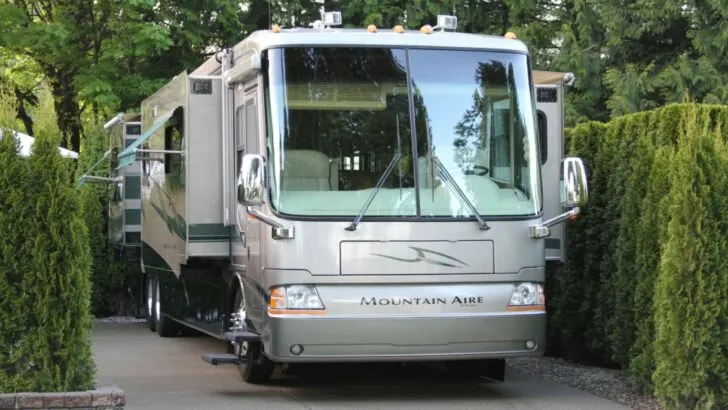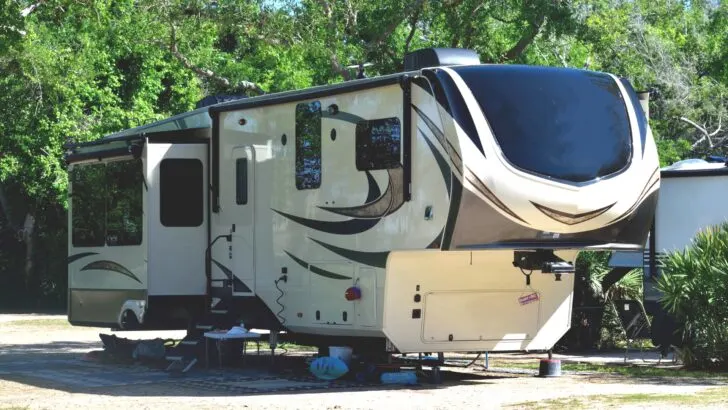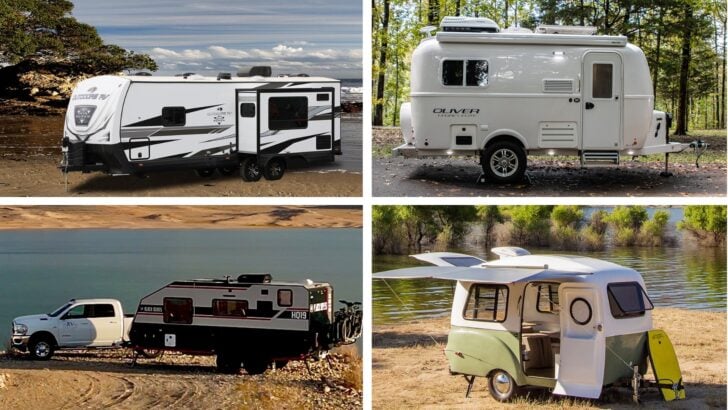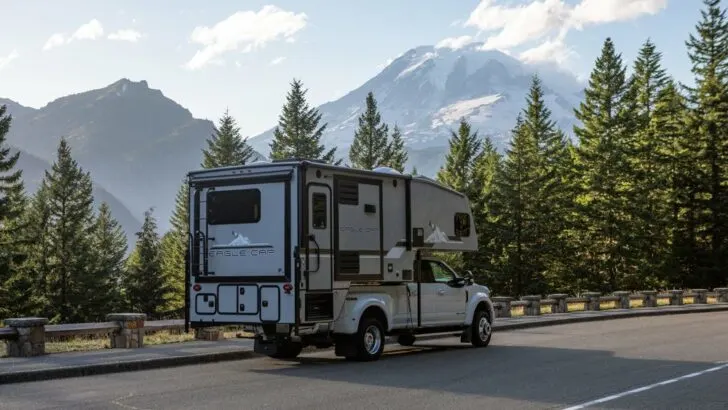Understanding the different classes of RVs is important for helping you figure out which type might work best for you. So much varies, from sleeping areas to creature comforts to fuel efficiency to price. When, where, and how you like to travel and camp is a huge factor in making the best choices of RV class, type, floorplan, and gear.
We’re breaking down the various RV classes, both motorized and towable, to outline the pros and cons of the different types of RVs. Anyone who’s in the process of determining which class of RV is likely to work best for them will appreciate today’s post.
A Guide to the RV Classes
There are several different classes of RVs, both motorized or towable, each with its own potential advantages and disadvantages. Here’s a breakdown of the various types of RV, each of which is perfect for some RVers. Depending on your preferred traveling and camping style, at least one of them is probably the best choice for you, too.
Motorized RVs (Motorhomes)
Within the category of motorized RVs (motorhomes, which are driven rather than towed), there are several sub-classes, each with its own advantages and disadvantages.
Class A RVs
Class A RVs are typically (although not always) the largest recreational vehicles, reaching as long as 45 feet. They can be either gas- or diesel-powered and typically look more like buses than other types of RVs. Class A rigs are most commonly available in two flavors: “Diesel Pushers,” with a diesel engine at the rear, and “Gassers,” which have a gasoline-powered engine, typically mounted in the front of the motorhome.
Diesel Pushers
This sub-category of “Class A motorhomes” is arguably the highest-end RV available. They’re usually the most expensive and best-equipped RV models you can buy. Our 2005 43′ Newmar Mountain Aire was a typical diesel pusher, but this category also technically includes Bus Conversions, which are generally the most expensive custom luxury RVs that money can buy.
Over the years, a few Class A diesel models have had engines mounted up front, referred to as a FRED chassis, for FRont Engine Diesel. There have even been a few mid-engine diesel RVs. There are also school bus conversions, affectionately known as “Skoolies” which can be either diesel- or gasoline-powered.
But the vast majority of diesel-powered Class A motorhomes have their engines mounted at the rear of the RV, hence the popular moniker “diesel pusher” as their engines push them from the rear.

Our 2005 43′ Newmar Mountain Aire is a typical diesel pusher. The new owners are continuing to enjoy living in it as we prepare to take delivery of our new rig very soon!
While diesel pushers are the most expensive RVs, they do offer a lot of advantages, including the following common benefits:
- Powerful, durable engines
- Quiet cockpit (partly due to the engine being so far behind you)
- Smooth air-ride suspension
- Greater towing capacity
- Decent fuel mileage for their size and weight
- Typically include more luxuries and amenities
- More, and higher-end, options are usually available
- Large basement storage compartments
- Robust chassis for longevity and smooth, quiet ride
- Components and build quality tend to be higher
As with any choice, Diesel Pushers have some negatives as well. We mentioned that they’re the typically most expensive rigs you can buy. That’s certainly not a positive, at least in our book! And more “stuff” usually equals a bigger learning curve and more things to go wrong. They’re also big, meaning you may not be able to take one to your favorite National Park campground.
Speaking of size… one of our most common pieces of advice is “Buy the smallest RV you think you can be comfortable in.” While we spent more than 18 years full-timing in a 43′ diesel pusher, we’re taking our own advice in a big way. As this post is coming out, we’re about to take delivery of our brand new RV, which will be less than half the size of our motorhome! Stay tuned for details, coming soon.
For a more detailed view of the advantages of a diesel pusher check out our post on diesel Class A motorhome benefits.
Gas Class A (“Gassers”)
A gas Class A RV is simply a Class A motorhome with a gasoline engine, usually mounted up front. These motorhomes typically have the engine sitting under a hump between the front seats, which is often referred to as the “Dog House.”
Gas Class A motorhomes have advantages, too, not the least of which is their cost. They’re usually far less expensive than diesel pushers and often include as much, or almost as much, living space. Since gassers are available in lengths up to about 38′-40′, that shouldn’t come as a surprise, especially compared to any diesel pusher that’s 40′ long or less.
In cars, gasoline engines usually accelerate faster than their diesel counterparts. But that doesn’t always hold in the RV world, especially with the turbochargers and high torque ratings often found on diesel motorhomes. I recently drove a friend’s 34′ gasser back from California to British Columbia after she fell and broke her wrist, leaving her unable to drive home. I can tell you that our diesel pusher would easily win that drag race.

This is Peter standing in front of our friend’s 34′ Class A motorhome after he drove it 1,200 miles in just two days to get it and its injured owner back to Canada from California. To the untrained eye, this Class A RV may appear to be a diesel pusher, but it’s actually powered by a gasoline engine mounted up front.
When it comes to maintenance, gas Class A RVs typically have lower ongoing costs than diesel pushers. Qualified diesel mechanics and diesel engine parts typically cost more. Gas rigs also have no air systems to maintain or repair. And the lower level of luxury and tech equipment commonly found in a gas rig helps keep ongoing costs down, too.
In terms of disadvantages, because gas-powered Class A RVs have their engine mounted at the front, you’ll hear more engine noise when driving or riding as a passenger. And, with the engine occupying the front of the RV, it’s not uncommon for the onboard generator to be mounted near the rear, often near/under the bedroom… which can be a consideration if you need to run the generator when you want to sleep.
Class C RV
A Class C RV is the middle child of motorized RVs, sitting squarely between the Class A and Class B rigs (oddly enough) in size. Class C RVs can vary widely in length from as little as about 21′ to as long as 45′.
However, they’re often the RVs that provide the greatest sleeping capacity. For this reason, they’re often the best choice for those who travel with larger families. They’re often more affordable than their Class A and Class B counterparts, so they’re a good fit for more budgets.
You can generally recognize Class C RVs by the “cabover” design that sits above the driver and front passenger area. This space, usually including a large bed, is surely a popular sleeping area for kids.
Class C motorhomes are just about the most popular type of rig in the rental market. That’s probably because Class Cs are a great combination of easy-to-drive, plenty of sleeping space, and modest cost of operation. And since they’re motorized, no secondary vehicle is required to tow it. Their (typically) modest size compared to a Class A also makes them a little more errand-friendly, so no “toad” (towed car) is required to get around town.

A Class C RV is generally recognized by the cabover design that extends out over the cockpit.
Super C RV
When built on a larger, heavier-duty chassis, a Class C RV can also be known as a “Super C.” Super C RVs offer a heavier-duty vehicle, a larger chassis, more space, and more towing power. They’re also more expensive.
For details including the pros and cons of Super C RVs and a tour of a Super C that we filmed at the RVX show in Salt Lake City, see our post entitled, “What Is a Super C RV?”

This is us at the Newmar booth at the RVX show in Salt Lake City, UT in 2019, introducing Newmar’s then-new Super C RV model, the Super Star.
Class B RV
A Class B RV is sometimes referred to as a “campervan. These rigs are often built from the ground up to be RVs (as opposed to converted campervans which can start off as cargo or utility vans).
This type of rig is usually set up to be a well-equipped motorhome in a tiny package. They generally provide many of the same benefits as larger RVs, including kitchen, shower, toilet, sleeping quarters, fresh & waste holding tanks, and storage compartments.
Class B rigs are typically well-thought-out and well-laid out, which is necessary to make the most efficient use of their smaller space. They provide most of the amenities one might expect from an RV — just shrunk down a bit. As we noted in our post on the benefits of smaller RVs, bigger isn’t always better.
On the “pro” side, they’re very easy to drive, park, and maneuver through both city streets and campgrounds. They also get better fuel economy. On the “con” side, space can be pretty tight in a Class B RV. Most Class B RV owners approach camping with the idea being that you’re living OUT of your RV, as opposed to living IN your RV. This photo of us enjoying breakfast in Australia shows us doing just that.

Here we are enjoying “Brekky On The Barbie” during our first international RV trip in 2016. We spent over a month in this Class B campervan driving from the Great Barrier Reef down to Sydney, Australia.
Class B+ RV
Manufacturers designed the Class B+ motorhome for people who wanted something a little bigger than a Class B RV but didn’t want a rig with the classic overhang of a Class C RV. But in truth, the “Class B+ RV” is more of a marketing term than an official Class of RV.
When the owner of a so-called “Class B+ RV” registers and insures the rig, it’ll be registered and insured as a Class C. This is because Class B+ RVs are built on the same type of chassis cabs that Class C rigs use, but they do away with the overhang you see on traditional Class C rigs.
B+ RVs have gained in popularity because, while they’re very easy to maneuver, they also offer considerably more space than Class B RVs. Four of our five international RV trips (Italy, England, New Zealand, and France/Italy/Spain) have been in Class B+ rigs. With these trips typically lasting us about a month at a time, we can attest to the comfort and versatility of these great rigs.
For more details, check out our post on the Class B Plus RV and watch our video tour of the Class B+ rig we rented in New Zealand:
Van Conversion
A van conversion is essentially the same class of RV as a Class B, but rather than being built from the ground up as an RV, a van conversion is usually a cargo or passenger van that is converted into an RV.
Often with van conversions, people add windows, vent fans, and as many amenities as they desire on the inside of the van to accommodate their traveling and camping needs. To see how to cut open the side of a cargo van and install a window, check out our post and video about van conversion window installation.
Towable RVs
As you might expect, the term “towable” refers to RVs that aren’t motorized but are instead towed behind another vehicle. Towables come in all shapes and sizes from tiny “teardrop campers” to gigantic homes on wheels.
Fifth-Wheels
A Fifth Wheel (often referred to as a “5th wheel” or a “5er”) is a camping trailer that’s pulled behind a pickup truck. But 5th wheels attach to a specialized hitch mounted into the bed of the truck, rather than connecting to a typical hitch ball beneath the towing vehicle’s rear bumper.
That’s right… this is the one class of RV that can only be used with a pickup truck (other than the super heavy-duty semi-trucks you’ll occasionally see towing the largest 5th wheels).
This configuration positions the RV’s weight directly over the truck’s rear axle, increasing stability, reducing sway, and decreasing fatigue on long driving days. This manner of towing is a significant distinction of a fifth-wheel camper from other types of travel trailers.
The distinctive front end of a 5th wheel makes it instantly recognizable, with the front cap sitting up over the bed of the truck.

Fifth wheels are distinguished from other travel trailers by the front cap. This is the area that attaches to the truck that tows the RV.
Fifth-wheel RVs can be huge, though the bigger and heavier they are, the bigger and more powerful the truck will be needed to tow them. Their floor plans allow for multiple levels and slide-outs. The large living area afforded by the space they offer is possibly the biggest reason why these rigs are so popular with full-time RVers.
The main advantages of fifth wheels are space, a superior towing experience compared to bumper-pull travel trailers, home-like interiors & amenities, and value. The fact that 5ers can be so large while forgoing an expensive drivetrain makes them very appealing from a cost standpoint.
Disadvantages include the fact that 5th wheels can be very large and heavy, requiring a powerful (and expensive) truck to tow one, and the loss of truck bed space due to the hitch. Fifth-wheel hitches also tend to require more maintenance than the simple ball hitches that tow regular travel trailers.
For more details, see our posts: “What Is a Fifth Wheel?” and Luxury Fifth-Wheel Campers.
Travel Trailers
A travel trailer (also called a “bumper pull” trailer) is an RV that’s towed using a hitch receiver on, near, under, or mounted to the bumper of the towing vehicle. As mentioned, 5th wheels mount to a specialized hitch in the truck’s bed.
The term “travel trailer” actually refers to how the towable is pulled — with a ball hitch and coupler. If it connects to a ball on the back of the tow vehicle, it’s a travel trailer.
Travel trailers come in all shapes, sizes, and types. They include everything from large bumper-pull RVs to fiberglass units like Casitas, Scamps, and Oliver travel trailers. There are also Airstreams, and off-road campers like the Black Series HQ19 that we spent a month traveling in last year, and even the little Happier Camper HC1.

Travel trailers come in many different sizes, shapes, and types. The Black Series HQ19 in the lower left is the one we spent a month in last year. Wait until you see our new rig, coming soon. Yes, it will be a travel trailer!
Pop-Up Trailers
Another type of travel trailer is the pop-up, a small RV that’s popular with young families just beginning their RVing experiences.
A pop-up camper is a small towable RV that is lightweight and collapses for easy transport. When a pop-up camper reaches its campsite and is expanded, it allows for significantly more interior space than appears when the camper is collapsed.
Pop-up campers can be budget-friendly and easy to tow behind smaller vehicles like minivans and SUVs. Some of our closest friends spent every summer towing the little pop-up camper all over the country being their mini-van, exposing their three young kids to fantastic family experiences and exploration. Being a school teacher allows for lifelong summer vacations!

A pop-up camper is lightweight and compact enough to be towed by a minivan or SUV but expands when set up for camping. Our friends (a family of five!)traveled all over North America this way every summer for years.
Hybrid Trailers
A hybrid trailer is a cross between a typical, soft-sided pop-up trailer and a traditional hard-sided travel trailer. The word “hybrid” implies a combination of two things, and in the case of hybrid campers, the combination is that of a hard-sided travel trailer and soft-sided pop-up-like expansions.
Hybrid campers have a smaller overall footprint, but once the pop-up or pop-out sections have been expanded, they can have living and sleeping capacities similar to much larger travel trailers. They’re also lighter than many traditional travel trailers, allowing them to be towed by a wider range of vehicles.
For more detail and a look at the pros and cons of this type of travel trailer, see our post on hybrid campers.
A-Frame Trailers
A-frame travel trailers are essentially hard-sided pop-ups. They typically have fold-down rigid roof panels that collapse for storage and travel and pop up into a peak or A-frame when set up for camping.
A-frame travel trailers are generally fairly small and have room for a bed or two, a small kitchenette area, and a dinette. Most don’t have bathrooms, but a few sort of have cassette toilets like the one we discussed in our post on A-liners. An advantage of A-frame trailers is that many are light enough to be towed by a car.
Teardrop Trailers
Teardrop trailers are another type that’s lightweight and compact enough to be towed by an SUV, minivan, and some cars, depending on the size and weight of the teardrop.
These travel trailers get their name from their shape and vary widely in size and amenities. Some are essentially a bed on wheels, while others have outdoor kitchens, air conditioners, full “wet bath” bathrooms, and storage.

Teardrop trailers are small travel trailers that vary widely in size but share a similar shape — a teardrop.
Truck Campers
A truck camper is another type of “towable” RV, though it’s not pulled on the back of a vehicle. Instead, it sits in the bed of a pickup truck, basically allowing the truck to carry the camper on its back.
Some truck campers are hard-sided, while others are hybrid, with hard sides that collapse for travel and raise up to expand the living space once you’re at your destination.
Truck campers can be fairly basic while others are fully appointed with more than one bed, a dinette (that may also convert to a bed), a kitchen area, and even a bathroom with a shower. Some larger models even have dry baths.

This is an Eagle Cap camper from Adventurer Manufacturing, one of the largest truck campers on the market. Big truck campers require big trucks to haul them. (Photo source: Adventurer Manufacturing)
Toy Haulers
A toy hauler isn’t really an RV category, but due to its specific and distinctive purpose, we’ll put this one in its own little category anyway.
A toy hauler is actually a type of floorplan. The term “toy hauler” refers to any RV with a garage in the back to carry “toys” like ATVs, motorcycles, recreational gear, etc. A toy hauler can be a Class A motorhome, a fifth wheel, or a travel trailer — any RV with a garage for hauling toys.

A toy hauler is any RV with a dedicated garage for carrying ATVs, golf carts, motorcycles, bicycles, kayaks, or other types of recreational gear. Toy haulers can be identified from the outside by their rear garage door.
As you can see, there are several classes of RVs with different categories within each class. The key is to determine exactly what you need or want in a camper and consider all of the classes and types available.
Once you’ve figured out which class of RV is right for you, you can choose your floorplan, and decide whether you’ll focus on the new or used RV market. Check out our video below for lots of tips on buying new vs used:
Free RVing Tips, Tricks, Reviews & Giveaways
As 20-year full-timers, we share everything we’ve learned about RVing over the years. Join our online community to receive a wealth of great RVing knowledge delivered daily to your inbox.
Whether you’re a new RVer or a seasoned full-timer, you’ll love the wide range of RVing topics we cover. Don’t miss a single article or any of our famous Giveaways. Subscribe to our newsletter today!


Gay Tacoma (Washington) Travel Enthusiast
Monday 22nd of April 2024
Another awesome story! I like to travel. Unless it's international travel, I like road travel. The problem I have is that most of the best RVs are 30' or longer in length, 30' or more in height, and probably weigh in at around 100k lbs. For a beginner RVer like myself, that's insanely large! Even a full-time RVer doesn't need that much vehicle to travel comfortably. I could probably drive a Mercedes-Benz Sprinter based RV and be comfortable, but I like mine to have a Turbo Diesel engine powering it. How many small (30' or smaller) Diesel Pushers do you know of offered here in the USA? I'd be surprised if there are any. Maybe you or someone reading knows of such RV?